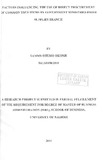| dc.description.abstract | Government ministries procure wide variety of goods and services using various methods of
procurement stipulated in the Public Procurement and Disposal Act, 2005 (PPADA) in order
to serve the public in various capacities. Among the goods and services procured by the
government ministries are Common User Items (CUI) which include furniture, stationery and
cleaning materials among others and are used in most if not all the government ministries.
Supplies Branch is a government entity mandated to coordinate the procurement of CUI by
government ministries. To fulfill its mandate Supplies Branch procures CUI in bulk and in
turn sale them to government ministries upon request and payment for the required CUI by
government ministries. The government ministries have continued to procure CUI from the
open market which is evidenced in many advertisements for prequalification of suppliers in
the print media. This study was interested in establishing factors influencing the use of direct
procurement of CUI from Supplies Branch by government ministries and challenges that
government ministries face when procuring CUI from Supplies Branch.
This was descriptive census design and therefore all the 42 government ministries were
considered in the study. Both primary and secondary data were used where primary data was
collected from procurement personnel from all the government ministries by use of
questionnaire. The data was analyzed using simple descriptive statistics of frequencies and
percentages.
The study revealed that various factors influence use of direct procurement of CUI from
Supplies Branch. Lower prices offered by Supplies Branch on CUI contributed positively to
the use of direct procurement of CUI. Despite the lower prices offered by Supplies Branch,
government ministries have been procuring more CUI from the open market due to a number
of factors including poor quality, longer lead times, unreliability resulting from stock outs,
lack of delivery services and government policy.
The study also revealed challenges facing the government ministries while using direct
procurement of CUI. These challenges were common across all ministries and they included
lack of transport services to enable ease collection of procured CUI from Supplies Branch.
This challenge is worsened by another one emanating from frequent stock outs and
inconsistent lead times. The requirement of paying upfront before the CUI procured from
Supplies Branch are issued was another challenge that lengthens already longer lead times.
Lack of clear government policy on the use of direct procurement of CUI was another
challenge the study revealed that government ministries were facing.
Due to time and financial constraints this study considered ministry headquarters and did not
give a chance of respondents from ministry who work outside Nairobi and source their CUI
from Supplies Branch depots situated in each of the seven former provinces apart from
Nairobi. Out of the 84 respondents targeted, 81 were available and responded while three did
not.
This study has suggested further research including investigation into whether there is value
for money to government ministries when procuring directly from Supplies Branch and also
investigation into the capacity of Supplies Branch to handle and coordinate procurement of
all CUI by government ministries. | en |

